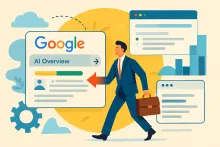
For years, building a successful online business meant one of two things: ranking high on Google’s search results or paying for visibility through ads. But that model is being rewritten—fast. Since Google introduced AI Overviews in May 2024, many websites have noticed a sharp drop in traffic, even when they still show up on search pages.
Instead of offering a list of links, Google’s AI Overviews provide users with instant, AI-generated answers at the top of the page. That’s great for searchers—but not so great for the websites providing the information. As a result, the traditional click-through model is collapsing, especially for businesses that rely on educational content to attract visitors.
A New Era of “Zero-Click” Searches
Recent data from Seer Interactive shows that organic click-through rates drop by 70% when AI Overviews appear in search results. Pew Research found that users are clicking on traditional search links half as often when AI summaries are present—and only 1% of people actually click on any link embedded within those AI summaries. In other words, even if your site appears in search, most users won’t visit it.
This change is already affecting consultants, content creators, e-learning platforms, and law firms that depend on educational content. Meanwhile, local businesses—like restaurants, plumbers, or carpenters—still get traffic through location-based searches. But experts warn that this reprieve is temporary. As AI evolves, no business is immune.
The Hidden Problem: Impressions Up, Clicks Down
The most dangerous part? Many businesses may not even realize there’s a problem. Impressions (the number of times a site shows up in search) might remain stable or even increase. But the actual number of visits—the clicks—plummets. That means fewer chances to tell your story, show off your services, or close a sale.
The SEO landscape is shifting from “How do I get clicks?” to “How do I stay relevant in AI-generated answers?”
Why It Still Matters to Show Up in AI Overviews
SEO experts like Andrew Shotland and Ben Fisher are encouraging businesses to rethink their approach. Surprisingly, even though AI summaries reduce clicks, they can still benefit your business.
Users tend to trust information shown in AI Overviews. If your business appears as a trusted source, that can build credibility and influence buying decisions, even if the user doesn’t click your link. Think of it as digital brand validation—and a potential source of higher-quality leads from people who are already informed and more ready to act.
What Small Businesses Should Do Now
To stay competitive, small businesses must adapt their digital strategies. Here’s how:
Keep your content accessible to AI: Don’t block AI crawlers from indexing your site. If Google’s AI can’t access your content, you won’t show up in overviews at all.
Invest in educational content: Even if it doesn’t generate as many clicks as before, appearing in summaries builds authority and visibility.
Manage your reputation proactively: Search your business online. If Google’s AI presents incorrect or misleading information, report the problem. You can do this by clicking the thumbs-down icon on an AI Overview, then selecting “Report a problem.”
Create diverse content formats: List-style articles, how-to guides, and especially videos tend to perform well in AI summaries. Expanding to platforms like YouTube or TikTok can also diversify your traffic sources.
Track more than just clicks: Start thinking in terms of lead quality and visibility, not just raw numbers. Visitors who click through after seeing an AI summary are often more engaged.
The Future of Search Is AI-Powered
In 2022, Forrester estimated that 59% of all retail transactions involved a digital component, amounting to $2.7 trillion in revenue. That number is expected to rise to $3.8 trillion by 2027. In this context, visibility in digital spaces—including AI summaries—has never been more critical.
While small businesses may not yet feel the full impact of Google’s AI Overviews, the trend is clear: AI is changing how consumers find and trust businesses. Those who evolve their strategies now—by improving their content, managing their presence in AI results, and expanding their digital channels—will be the ones who continue to grow in the AI era.
